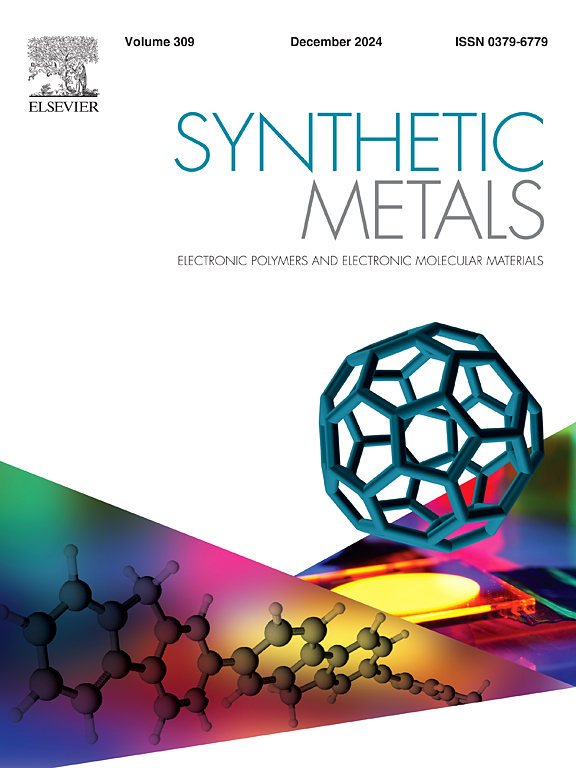通过电荷转移控制实现基于蒽的新型蓝色发光体
IF 4
3区 材料科学
Q2 MATERIALS SCIENCE, MULTIDISCIPLINARY
引用次数: 0
摘要
我们在二苯胺的基础上设计了具有不同电子负载效应和尺寸的新分子,并将其引入蒽中,合成了三种发光材料。这三种材料都具有很高的热稳定性,其玻璃化转变温度都在 175°C 以上,这证实了它们作为 OLED 发光体的潜力。掺杂了 N9,N9,N10,N10-四苯基蒽-9,10-二胺(TAD)(二苯基胺在两侧被取代)和 N9,N10-二([1、1′-联苯]-4-基)-N9,N10-双(二苯并[b,d]呋喃-2-基)蒽-9,10-二胺(ABFA)的 EQEs 分别为 1.分别为 1.28 % 和 3.57 %。由于分子内电荷转移(ICT),它们在 517 纳米和 538 纳米处显示出 ELmax 值。另一方面,掺杂了 N,N′-(蒽-9,10-二基双(4,1-亚苯基))双(N-([1,1′-联苯]-4-基)二苯并[b,d]呋喃-2-胺) (APBFA) 的器件实现了相对较高的 4.48 % EQE,并显示出 CIE 坐标为 (0.146, 0.142) 的蓝色发射。本文章由计算机程序翻译,如有差异,请以英文原文为准。
New blue emitters based on anthracene through charge transfer control
We designed new moieties with varying electron-donating effects and sizes based on diphenylamine and introduced them into anthracene to synthesize three types of emitting materials. All three materials exhibited high thermal stability with glass transition temperatures above 175°C, confirming their potential as OLED emitters. Devices doped with N9,N9,N10,N10-tetraphenylanthracene-9,10-diamine (TAD), where diphenyl amine is substituted on both sides, and N9,N10-di([1,1′-biphenyl]-4-yl)-N9,N10-bis(dibenzo[b,d]furan-2-yl)anthracene-9,10 diamine (ABFA), with a fused side group of diphenyl amine and dibenzofuran, showed EQEs of 1.28 % and 3.57 % respectively. Due to the intramolecular charge transfer (ICT), they exhibited ELmax values at 517 nm and 538 nm. On the other hand, the device doped with N,N′-(anthracene-9,10-diylbis(4,1-phenylene))bis(N-([1,1′-biphenyl]-4-yl)dibenzo[b,d]furan-2-amine) (APBFA), which has optimized side groups that suppress ICT and intermolecular packing, achieved a relatively high EQE of 4.48 % and showed blue emission with CIE coordinates of (0.146, 0.142).
求助全文
通过发布文献求助,成功后即可免费获取论文全文。
去求助
来源期刊

Synthetic Metals
工程技术-材料科学:综合
CiteScore
8.30
自引率
4.50%
发文量
189
审稿时长
33 days
期刊介绍:
This journal is an international medium for the rapid publication of original research papers, short communications and subject reviews dealing with research on and applications of electronic polymers and electronic molecular materials including novel carbon architectures. These functional materials have the properties of metals, semiconductors or magnets and are distinguishable from elemental and alloy/binary metals, semiconductors and magnets.
 求助内容:
求助内容: 应助结果提醒方式:
应助结果提醒方式:


